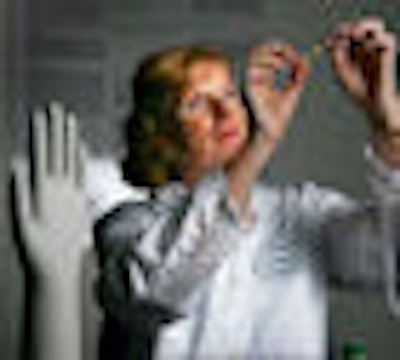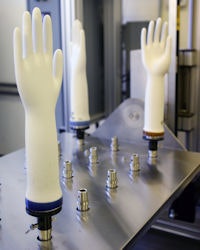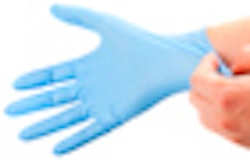
The familiar itching began in my right eye. Panic rising, I ran to the bathroom thinking, "Oh no, not again!" One glance confirmed what I already knew: That innocent looking baby doll I'd patted on the back during a CPR class was not so innocent. It contained latex. Nothing else makes my eyelids itch and swell within minutes of exposure. Was I destined for the emergency room for the second time in two months?
More than 3 million people in the U.S. are allergic to natural rubber latex. While that's only 1% of the population, the problem affects 8% to 17% of healthcare workers, according to the American Latex Allergy Association. At its worst, the reaction can cause fatal anaphylaxis. Constant vigilance is required to avoid latex, which is in more than 40,000 products, including many used daily in dental offices: dental dams, gutta-percha, bitewing tabs, toothbrush handles, anesthetic cartridges, prophy cups, orthodontic elastics -- and, of course, gloves.
 |
| Guayule latex gloves are scheduled to hit the market within a year. All photos courtesy of Yulex. |
In fact, while most hospitals have phased out latex, the majority of dental offices have not, and repeated exposure is causing a dramatic increase in allergy sufferers. While alternatives -- such as gloves made from synthetic materials like nitrile -- are available, many dentists complain the gloves are so thick that they interfere with tactile sensitivity.
So the news that a new alternative, guayule latex, is now commercially available has latex allergy sufferers and dentists alike excited.
The FDA approved guayule latex last year as safe for people with type I latex allergy. Yulex, an Arizona company, has developed technology for extracting latex from the guayule plant (Parthenium argentatum), which is native to the southwestern U.S. Yulex expects to release its first gloves, now on trial at Johns Hopkins, within a year. And today at the 2009 Western Regional Dental Convention in Phoenix, it introduced its first guayule latex product: a dental dam.
Until now, latex has come mostly from Hevea brasiliensis, a South American plant cultivated in Southeast Asia. The guayale latex products will be a little more expensive than Hevea latex products, according to Jim Mitchell, Yulex vice president of technology and development. But he argued that buying them will support the U.S. rubber industry.
The latex-free conundrum
Though latex gloves have been around since 1894, when Johns Hopkins pioneered them, latex sensitivity was scarcely an issue until the HIV epidemic hit, prompting manufacturers to speed up production by eliminating a step that leaches the gloves of protein. The increased protein content makes them more sensitizing because more "free" latex is present on the surface.
 |
| The guayule plant (Parthenium argentatum) is native to the southwestern U.S. and is being grown in Arizona and Australia. |
The potential routes of exposure for patients and staff are skin, mucous membranes, inhalation, and blood. Everything a staff member touches with latex gloves while assisting, cleaning, or doing lab work, for example, is contaminated by free latex. The loose proteins stick to the powder in surgical gloves. When gloves are donned or removed, the powder goes into the air where it can be inhaled, causing a serious allergic reaction.
Since latex is present in so many products found throughout a dental office, including mouse pads, adhesives, pens with comfort grip, and rubber stamps, creating a totally latex-free office is probably impossible. However, some doctors have successfully designed latex-safe environments by using alternative products.
Wendy Churchill, D.M.D., of Tampa, FL, was diagnosed with latex allergy in 1997 while still in dental school. "It was awful," she said. "I was just praying God would get me out of there because I couldn't control my environment." After graduation, she had a difficult time obtaining a position because doctors balked at the potential expense of buying latex alternatives and the liability posed by her condition. It took her a couple of years to build her own practice.
(The task has become easier as more substitutes for latex products have come on the market. For a list, visit the American Latex Allergy Association).
The products Dr. Churchill uses cost about the same or less than products containing latex, she said. She doesn't plan to rush out and buy guayale latex products right away. "I don't like to put my faith in the FDA too much. ... They approved Vioxx," she said. The FDA has a 1998 rule that requires all medical devices containing latex -- paradoxically including Yulex products -- to carry a warning about the risk of allergic reactions.
Make your office latex-safe
|
Types of latex allergies There are three types of latex reactions:
|
Dr. Churchill believes that latex can make or break a dental practice. "This is a life-threatening allergy. If a patient's airway closes up, you're in trouble." She also noted that one of her colleagues who failed to take the issue seriously enough had to retire after developing debilitating heart and respiratory problems. On the other hand, Dr. Churchill has patients who travel five hours to visit her latex-safe practice.
The key is to minimize the risk for susceptible patients and staff by taking a careful medical history, then using every available precaution to protect them. Don't forget the Rubbermaid gloves in the lab or the possibility that your lab tech wore latex gloves while polishing or packaging that crown. It is important to tell the lab about your patient's allergy on the prescription.
Wash prosthetics with soap and water before you insert them. Also, remind your staff to wash their hands before and after wearing latex gloves. Don't just use hand sanitizer. If you purchase latex gloves, always get powderless ones. If a patient does have an inadvertent reaction during treatment, early intervention is essential.
In my case, the sensitivity grew gradually. After eight years in practice, I developed dermatitis. But I thought I'd controlled the problem by using synthetic gloves and coping with the occasional lapse with diphenhydramine (Benadryl). Then last December I had to rush to the emergency room for treatment with epinephrine, famotidine (Pepcid), and diphenhydramine. When the symptoms came again -- ironically during that CPR course -- I was able to stave them off with epinephrine and diphenhydramine on my own.
Going forward, I've realized my future depends on a lot more than wearing the right type of glove and masks. Latex is everywhere. And I'm hoping more of my colleagues realize that.
Monica "Dr. mOe" Anderson, D.D.S., is a general dentist, writer, and motivational speaker in Austin, TX.
Copyright © 2009 DrBicuspid.com



















